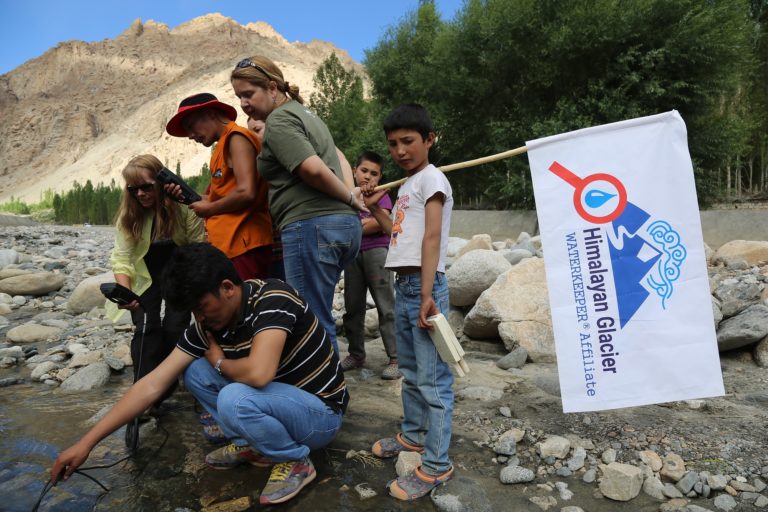
This piece was co-written with Cheryl Nenn, Milwaukee Riverkeeper, and Christine Ellis, Waccamaw Riverkeeper.
By July 19, after days of traveling, our team had all arrived in Ladakh, India, tired but excited to train a growing network of Waterkeepers in the Himalayas. This Waterkeeper training was part of Waterkeeper Alliance’s Himalayan Water Project, in partnership with Live to Love International and Himalayan Glacier Waterkeeper, to protect Himalayan glaciers and rivers from pollution and climate change.
It took just a couple of days for us to see firsthand the devastating effects of climate change in the Himalayas, and feel the urgent need for our work. On our drives to meetings and sites, we saw dry stream beds everywhere; in some instances, new developments were being built directly on top of them. This new development is concerning in the face of increasingly volatile wet weather events like cloud bursts, which are like Himalayan ‘tsunamis’ that have devastated communities, taking lives and livelihoods. Rapid development, particularly in Leh, the capital city of Ladakh, is occurring as a result of increased tourism. Development seemed rampant and often in locations with no discernible water supply (many homes in outlying areas are serviced with rain cisterns and have water delivered via truck). We fear that, combined with decreasing water supplies as glaciers retreat, development in these high alpine areas may be unsustainable.
Adding to the threat of decreasing water supplies is the pollution of Ladakh’s streams. Providing Waterkeepers with the tools and training to monitor the quality of these streams ensures their ability to protect water resources and prevent pollution in the future.
On July 20, at a special event held at the Druk Padma Karpo School, we launched the Himalayan Water Project with Himalayan Glacier Waterkeeper, led by the charismatic and accomplished Padma Tashi, in the presence of His Eminence Thuksey Rinpoche, one of two spiritual heirs to His Holiness the Gyalwang Drukpa, leader of the Drukpa lineage of Buddhism and founder of our Waterkeeper network in Ladakh. We were honored by the Chief Executive Councillor of the Ladakh Autonomous Hill Development Council, Dr. Sonam Dawa Lonpo, and joined by Himalayan Glacier Waterkeeper’s 20 Affiliates, all of them Drukpa monks responsible for protecting the good of their communities. Also in attendance were Drukpa nuns, students from the school, and members of the community, all of whom have a vested interest in preventing pollution and protecting clean water.
Prior to our launch event, we had witnessed locals washing their trucks, cars, and carpets on a tributary of the Indus River – despite signs saying that this was illegal. Algal blooms in the stream were evidence of the pollution caused by these activities. A day after our launch, we noticed that these activities had stopped as a result of access to the tributary being blocked. Later we learned that His Eminence had asked the Chief Executive Councillor to intercede and stop these polluting practices by bulldozing entrances to the stream.
We rejoiced in this small but significant first achievement by Himalayan Glacier Waterkeeper and in the news coverage that resulted from our launch: a front page headline in Ladakh’s major newspaper, and prime-time coverage on television and radio news.
From there, our focus turned to our training duties. At Druk Padma Karpo School, the site of the famous Bollywood movie ‘3 Idiots’, we trained the Himalayan Glacier Waterkeeper team and its 20 Affiliates on the use of water quality monitoring field equipment from YSI. We also trained Drukpa nuns and students from the school on how to test water quality using Earth Echo’s World Water Monitoring Challenge kits. With these tools, Himalayan Glacier Waterkeeper’s community is able to monitor baseline physical and chemical water quality conditions of their local waterways and advocate for the protection of clean water.
In the days following our classroom training, we drove over 500 km through the most spectacular terrain to provide on-site training for our 20 Affiliates. We trained the Drukpa monks streamside within their villages, and experienced their gracious warmth and hospitality — drinking tea within the gompa (monastery) and by the streams. By the end of our tour, we had tested water quality at 10 sites northwest and southeast of Leh. Our initial testing found the water quality of glacial streams to be generally good (dissolved oxygen at levels supportive of aquatic life, slightly alkaline, low conductivity, high clarity, no excessive nutrients). For the Indus and the Zanskar Rivers, both larger river systems, the main difference was low clarity and highly turbid water resulting from excessive suspended sediments in the water. Ongoing water quality testing will help to establish baseline characteristics of these waterways and allow Waterkeepers to assess and address any changes that may occur from pollution or climate change.
We are thrilled with the level of dedication and enthusiasm of Himalayan Glacier Waterkeeper’s team and the Drukpa monk Affiliates, all now part of our Waterkeeper family. There is no better group to keep Ladakh’s streams and rivers clean. The Ladakhi word for stream is ‘tokpo’, also the word for ‘friend’. Waterkeepers know that streams are our friends, and friends are definitely worth protecting.